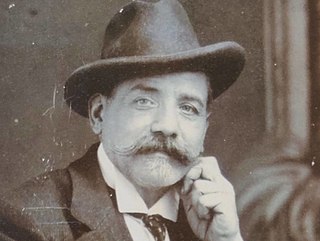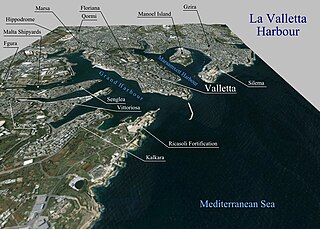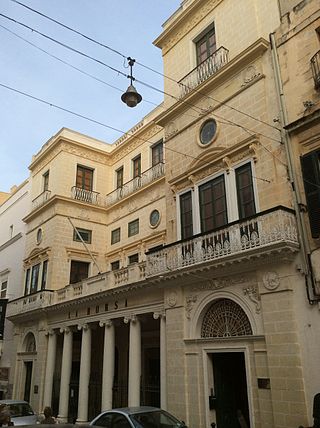
Giuseppe Calì was a Maltese painter of Italian descent.

Sliema is a town located on the northeast coast of Malta in the Northern Harbour District. It is a major residential and commercial area and a centre for shopping, bars, dining, and café life. It is also the most densely populated town on the island.

Paola is a town in the South Eastern Region of Malta, with 8,706 inhabitants as of 2019. The town is a commercial centre in the Southern Harbour area of Malta, about 5 km from the capital Valletta, contiguous to Tarxien and Fgura, with which it forms a single urban area. Paola is named after Grand Master Antoine de Paule, who laid the foundation stone in 1626.

The Grand Harbour, also known as the Port of Valletta, is a natural harbour on the island of Malta. It has been substantially modified over the years with extensive docks, wharves, and fortifications.

Maltese architecture has its origins in prehistory, and some of the oldest free-standing structures on Earth – a series of megalithic temples – can be found on Malta. The islands were colonized by the Phoenicians and later the Romans, who established the cities of Melite and Gaulos. Although these were substantial settlements and are known to have had numerous temples, churches and palaces, few remains have survived apart from some architectural fragments.

The coastline of Malta consists of bays, sandy beaches, creeks, harbours, small villages, cities, cliffs, valleys, and other interesting sites. Here, there is a list of these different natural features that are found around the coast of Malta.

Giovanni Caruana was a Maltese lawyer and minor philosopher. He was mostly interested in the philosophy of law and in political economy. At least two portraits of Caruana exist, both by the renowned early 20th century Maltese artist Edward Caruana Dingli. Both were displayed at an exhibition on Caruana Dingli at the National Museum of Fine Arts in Valletta, Malta, in 2010.

In Malta most of the main roads are in the outskirts of the localities to connect one urban area with another urban area. The most important roads are those that connect the south of the island with the northern part, like Tal-Barrani Road, Aldo Moro Street in Marsa and Birkirkara Bypass.

Giuseppe Bonavia was a Maltese draughtsman and architect who was mainly active in the second half of the 19th century. Born in Valletta, he was initially a clerk of works with the Royal Engineers, before becoming the Head of the Civil Service Works Department.

The Parish Church of Our Lady of Mount Carmel, or simply known as the Carmelite Church or Balluta Parish Church, is a neo-gothic Roman Catholic parish church located in Balluta Bay in the town of St Julian's, Malta.
Webster Paulson was an English civil engineer who is known for his work in Malta in the late 19th century.

The Great Siege Monument, also known as the Monument to the Fallen of the Great Siege, is a monument commemorating the Great Siege of Malta located in Valletta, Malta. It consists of three bronze figures symbolizing Faith, Fortitude, and Civilization, standing on top of a granite base. The monument is the work of the sculptor Antonio Sciortino, and it was inaugurated on 8 May 1927.

Giuseppe or Joseph Psaila (1891–1960) was a Maltese architect. He graduated from the University of Malta in around 1915, and he was one of the few Art Nouveau architects in Malta since at the time neoclassicism was still popular, especially in the case of public buildings. He was influenced by the work of the Italian architects Raimondo D'Aronco and Ernesto Basile.

The Turkish Military Cemetery, also known as the Ottoman Military Cemetery, is a cemetery in Marsa, Malta. Commissioned by the Ottoman sultan Abdul Aziz to replace an earlier Muslim cemetery, it was constructed between 1873 and 1874. The cemetery was designed by the Maltese architect Emanuele Luigi Galizia, and it is built in an exotic orientalist style. It is maintained by the Turkish government. Originally the cemetery was referred to as the Mahomedan Cemetery such as on documents, and also referred to as the Martyrs’ Cemetery in Turkey such as on a historic painting.

Gustavo Romeo Vincenti was a Maltese architect and developer. Born into a wealthy and business oriented family in Valletta and Floriana, he was able to purchase land and design and build buildings which he would then sell to clients. He was interested in architecture from a young age, and he graduated as an architect from the University of Malta in 1911, at the age of 23.

Alberto La Ferla (1898-1942) was a Maltese architect, active in the 1920s and 1930s.

Silvio Mercieca (1888–1954) was a Maltese architect.

Joseph or Giuseppe Cachia Caruana (1894-1981) was a Maltese architect active in the Sliema area.






















